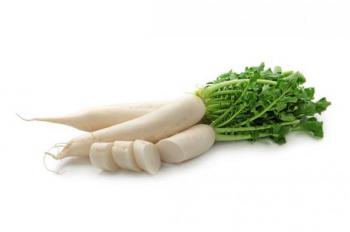There is a Lot to Love About Radishes
TEXARKANA, Ark. –
Crunchy, zingy, peppery … These are all words that describe a radish. It is not an attractive vegetable, nor is it typically a popular one unless you are adding it to a vegetable tray, or to a salad. There is a lot to love about the radish.
The popular red globe radish is low in calories with an abundance of flavor and crunch. A 1/2 cup serving (about 12 medium) of sliced radishes provides a good amount of potassium, vitamin C, folate and fiber. Winter radishes such as daikons are similar in nutrients.
The vitamin C in radishes is an antioxidant that may reduce your risk of heart disease and certain cancers. Vitamin C also helps protect the skin from bruising; helps heal cuts and keep gums healthy. Eating foods with vitamin C helps the body absorb iron.
Potassium and folate are also found in radishes. Potassium helps maintain a healthy blood pressure and folate may reduce your risk of heart disease. Eating foods with folate before pregnancy helps lower the risk of delivering a baby with neural tube defects.
In fact, a one half cup serving of fresh sliced raw red globes will yield 12 calories, .0.35 grams protein, 2 grams carbohydrates, 1-gram dietary fiber, 134.56 mg potassium, and 15.66-mcg folate.
To reap all the nutrition benefits from radishes, they should be stored properly. Store them in the refrigerator once the tops have been removed. The radish leaves cause moisture and nutrient loss during storage. Store greens (leaves) separately for 2-3 days. Refrigerate radishes wrapped in plastic bags for 5 to 7 days. Winter radish varieties can be stored for up to two weeks in the refrigerator.
Summer and winter radishes are most often eaten raw, but they can be grilled or added to stir-fry’s. Use a stiff vegetable brush and scrub radishes under cold running water. It is not necessary to peel them. Pare away the top and root end then slice, dice, shred, or serve whole. Large Chinese and Japanese varieties hold up well during cooking. They can be eaten raw, preserved or substituted in any recipe calling for turnips.
Daikon radishes, also known by many other names depending on context, is a mild-flavored winter radish. It is recognizable by its leaves and a long, white, napiform root. They are thought to aid in digestion, especially the digestion of fatty foods. It is a common ingredient in Japanese cooking and is always grated and added to tempura dipping sauce. Young daikons can be eaten raw. Always peel daikons. Larger than 8 inches, they should be cooked by simmering in stews and soups. Daikon tastes light and refreshing rather than heavy or starchy.
This Radish Green Pepper Salad is courtesy of Michigan State University Extension Project Fresh. It has minimal ingredients and is quick to make. Plus it gives you another way to use radishes.
Radish Green Pepper Salad
20 radishes, sliced thin with ends trimmer off
1 green bell pepper, sliced fine
Dressing:
2 tablespoons vinegar
4 teaspoons soy sauce
1 tablespoon sugar
Combine the radishes and green bell pepper. Mix dressing ingredients, stirring them well to dissolve the sugar. Add the dressing to the vegetables and mix well.
For more information, contact the Miller County Extension Office, 870-779-3609 or visit us in room 215 at the Miller County Courthouse. We're online at chadley@uada.edu, on Facebook at UAEXMillerCountyFCS/CarlaDueHadley, on Twitter @MillerCountyFCS or on the web at uaex.uada.edu/Miller.
By Carla Haley-Hadley
County Extension Agent - FCS
The Cooperative Extension Service
U of A System Division of Agriculture
Media Contact: Carla Haley-Hadley
County Extension Agent - FCS
U of A Division of Agriculture
Cooperative Extension Service
400 Laurel Street, Suite 215 Texarkana AR 71854
(870) 779-3609
chadley@uada.edu
Related Links
The Arkansas Cooperative Extension Service is an equal opportunity institution. If
you require a reasonable accommodation to participate or need materials in another
format, please contact your County Extension office (or other appropriate office)
as soon as possible. Dial 711 for Arkansas Relay.
Pursuant to 7 CFR § 15.3, the University of Arkansas System Division of Agriculture
offers all its Extension and Research programs and services (including employment)
without regard to race, color, sex, national origin, religion, age, disability, marital
or veteran status, genetic information, sexual preference, pregnancy or any other
legally protected status, and is an equal opportunity institution.
